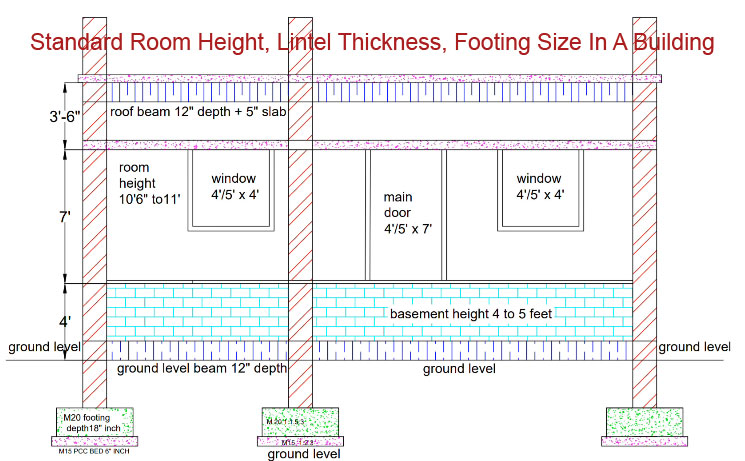
Standard Room Height, Lintel Thickness, Footing Size In A Building
In this civil engineering article, detail information is provided on the standard room height as well as standard thickness of lintel and standard footing size.
Initially, pit measurements for excavation should be 4 x 4 (Length x Breadth). It depends on the bearing strength of soil. The depth should be up to hard strata.
Then PCC bed should be arranged with 6 inches thickness. Here, M15 grade of concrete should be used with ratio 1:2:4 i.e. One part cement : Two Parts Of Sand : Four Parts Of Course Aggregates.
After that, footing should be provided with height or depth 18 inches. In footing M20 grade concrete should be used with ratio 1:1.5:3. Alternatively M15 grade of concrete can be used with ratio 1:2:4.
Then, beam should be arranged on ground level where black cotton soil or agriculture soil is present. The depth of beam should be 12 inches.
Then, basement should be constructed. Here, proper height should be maintained from ground to door level. It is known as basement height and the height should be 4 to 5 feet.
The height of the room should be 10 feet 6 inches to 11 feet.
The spacing among the door and lintel should be 7 feet. The thickness of lintel should be 6 inches.
The height of the window should be 4/5 feet x 4 feet. In hall room, the height should 4 x 6 feet.
Over the windows, the lintels should be arranged and their height should be 6 inches. M15 (1:1.5:3) or M20 grade of concrete should be used for lintels.
The height from lintel up to ceiling should be 3 feet 6 inches.
The depth of beams provided in rook should be 12 inches devoid of slab. The slab thickness should be 5 inches. So, including slab, it should be 12 + 5 inches.
To get more clear conception, go through the following video tutorial.
Video Source: Life is Awesome Civil Engineering Plans


